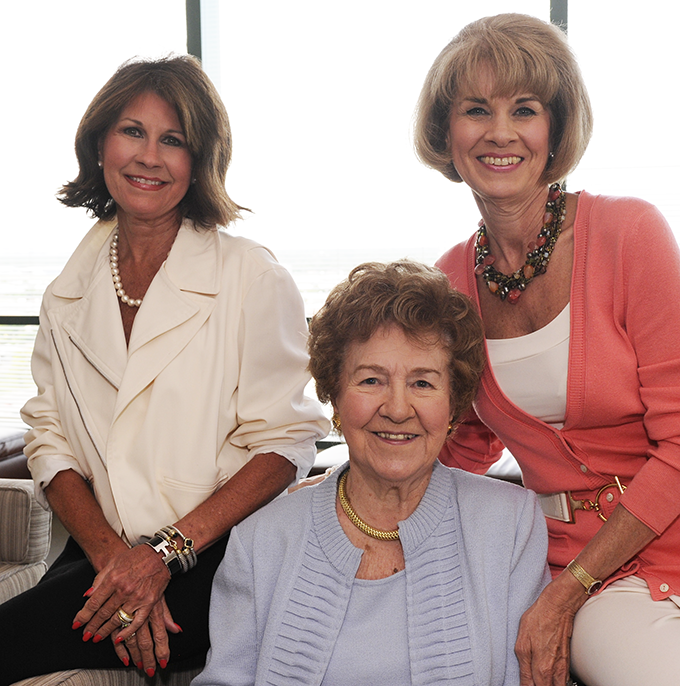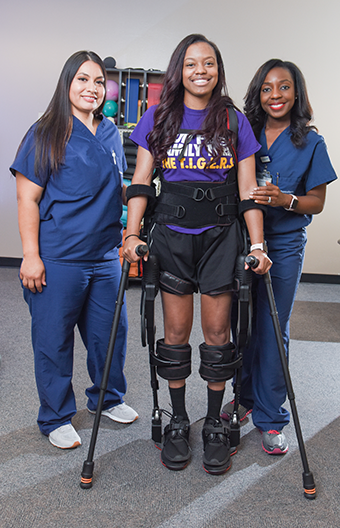Gift for exoskeleton technology enables those paralyzed to walk again

(From left) Bonnie Bell Harding, Mar Nell Bell, and Patti Bell Brown
By Sharon Reynolds
For those with leg paralysis, a wearable robotic suit called an exoskeleton can make their dreams of walking again come true. The framework of braces and assistive technology does what a patient’s own muscles and nerves cannot, supporting and moving lower extremities, and it is one of today’s most advanced and promising therapeutic rehabilitation tools.
To further those dreams, UT Southwestern’s Department of Physical Medicine and Rehabilitation recently acquired two exoskeleton robotic suits that support patients with lower-body weakness in their efforts to learn to walk again.
The A.L. Chilton Foundation’s $110,000 gift helped bring this technology to UT Southwestern. Patti Bell Brown and her sister, Bonnie Bell Harding, are members of the A.L. Chilton Foundation’s distribution committee, and they learned about the programs and needs of the Peter O’Donnell Jr. Brain Institute, including the exoskeletons, during the fall President’s Advisory Board meeting.
“We have been supportive of UTSW for many years, and its record of innovative research has certainly gained our trust and confidence,” said Ms. Brown. “New technology and equipment is always needed for patients with physical and mental challenges, and the meeting really enlightened us as to how we could help. The exoskeleton can help patients move their legs and reach a higher quality of life than previously imagined. This improved technology is quite exciting to us.”
“We are deeply grateful for the trust and confidence that the A.L. Chilton Foundation has placed in UT Southwestern over so many years,” said Dr. Daniel K. Podolsky, President of UT Southwestern. “The Foundation’s generosity has enabled a greatly enhanced rehabilitation experience for patients. With the therapy team’s use of the exoskeleton, we can offer even more hope to our patients struggling to regain their mobility.”
Exoskeletons assist a patient’s leg muscles so they can relearn correct step patterns, walk with proper support and posture, and master other skills that are essential to regaining mobility. Some UTSW patients have reported feeling a change in the sensation in their legs after just one therapy session with the exoskeleton.
Dr. Kathleen Bell, Professor and Chair of Physical Medicine and Rehabilitation, describes in one word the smiles on patients’ faces as they walk in the exoskeleton for the first time – priceless.
“The gift from the A.L. Chilton Foundation for the robotic exoskeletons is truly a gift of hope to our patients with stroke and spinal cord injuries,” she said. “Having access to this advanced technology has expanded the ability of our physicians and therapists to foster neurorecovery and healthy activity in our patients. Additionally, our ability to research improved methods for regaining ambulation and improving bone density and cardiovascular training has been greatly enhanced.”
The extraordinary friendship between UTSW and the A.L. Chilton Foundation has spanned more than six decades, with Foundation gifts totaling more than $6.25 million to support programs and research. The Foundation was established in 1945 in Texas by A.L. and Leonore Chilton. Mr. Chilton, who owned Sky Broadcasting Service, a chain of radio stations in Texas, Louisiana, and Arkansas, died in 1973. His close friend, the late F. Andrew Bell, and subsequently his widow, Mar Nell, and their daughters, Ms. Harding and Ms. Brown, carry on his philanthropic legacy.
The Chilton Foundation’s gifts to support Biochemistry programs previously established the Chilton/Bell Fund for Scholars in Biomedical Research; the Chilton/Bell Biochemistry Research Fellowship Fund; the Mar Nell and F. Andrew Bell Distinguished Chair in Biochemistry; The Sam G. Winstead and F. Andrew Bell Distinguished Chair in Biochemistry; and the A.L. Chilton Distinguished Visiting Professorship in Biochemistry. Other funding includes the Chilton Lectures, held annually since 1985; various pieces of medical equipment; and support for the construction of the Zale Lipshy and William P. Clements Jr. University Hospitals.
Dr. Bell holds the Kimberly‐Clark Distinguished Chair in Mobility Research.
Dr. Podolsky holds the Philip O’Bryan Montgomery, Jr., M.D. Distinguished Presidential Chair in Academic Administration, and the Doris and Bryan Wildenthal Distinguished Chair in Medical Science.
Pushing limits with the exoskeleton
|

Kiara Connley (center) with members of her UTSW physical therapy team Cynthia Robles (left) and Jeanne Vinson
Kiara Connley was an active and thriving college student when her health took an unwelcome turn. She noticed weakness, pain, tingling, and numbness in her joints and lost vision in her left eye.
Soon after, she woke up paralyzed from the waist down and was diagnosed with transverse myelitis, a rare and poorly understood autoimmune disorder. Ms. Connley was forced to put her studies on hold and devote herself to her recovery. She had to use a wheelchair for movement and required significant assistance to get through daily activities.
Her strong resolve and spirit aided in her rehabilitation, but Ms. Connley credits much of her progress in her recovery to therapy utilizing the exoskeleton.
“The exoskeleton has helped transform my body,” she said. “My posture has done a complete turnaround. I no longer walk hunched over, and my leg muscles are stronger and allow me to stand more firmly on the ground.”
Today, Ms. Connley is back in college and able to walk slowly without assistance. She dreams of becoming a physical therapist and helping others, just like her care team at UT Southwestern has provided guidance and support on her journey. “As difficult as things may get, never stop pushing yourself,” she said.
View a video of this story here.
|